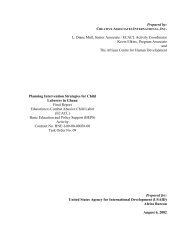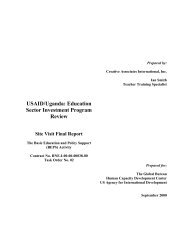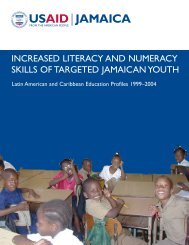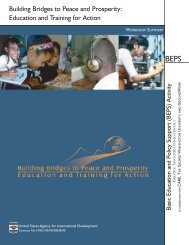Grandmothers: A Learning Institution - Basic Education and Policy ...
Grandmothers: A Learning Institution - Basic Education and Policy ...
Grandmothers: A Learning Institution - Basic Education and Policy ...
- No tags were found...
Create successful ePaper yourself
Turn your PDF publications into a flip-book with our unique Google optimized e-Paper software.
– Who am I? Assign children to askfamily members, including gr<strong>and</strong>mothers,to answer the child’s question:“Who am I?”This is an activityto help children define their ownidentity, in the family, <strong>and</strong> in thecommunity.– Living History. Assign children tointerview elders in their family orneighborhood, including gr<strong>and</strong>mothers,on a topic related to the historyof the neighborhood or village.Teachers can make this a part of thehistory curriculum.– Make curriculum relevant.– Build Ownership of the school curriculumby the community.– Making connections between the“old way” <strong>and</strong> the “new”.INTEGRATE TRADITIONAL VALUES INTOTHE CURRICULUM.• Collect stories, proverbs, <strong>and</strong> songs,<strong>and</strong> analyze the values expressed inthem. Use these traditional materialsas a basis for discussion of cultural values<strong>and</strong> of the similarities <strong>and</strong> differencesbetween traditional <strong>and</strong> modernvalues.DEVELOP PARTNERSHIPS BETWEENGRANDMOTHERS AND SCHOOLS.• Encourage families to create homeenvironments that support success inschool.• Encourage gr<strong>and</strong>mothers, who oftenhave more free time than mothers, towalk children to school to assure theirsafety.• Identify stories told by gr<strong>and</strong>mothersin the community that relate to thecurriculum <strong>and</strong> use these stories asteaching tools. Invite these seniorwomen to tell stories in special storytellingsessions at schools or in informalsettings.USE PARTNERSHIPS TO PROMOTESCHOOL IMPROVEMENT.• Empower parents to participate inschool planning for curriculum content,school climate, <strong>and</strong> staff development.• Identify gr<strong>and</strong>mother leaders <strong>and</strong> networks.• Form Gr<strong>and</strong>parent-Parent-TeacherAssociations.• Empower families to learn to use theircollective power to advocate forschool change.• Involve community elders, includinggr<strong>and</strong>mothers, gr<strong>and</strong>fathers, <strong>and</strong> religiousleaders, in providing input forquality control of schools <strong>and</strong> teacherperformance.Many of these recommendations do notdepend on large amounts of financialresources. They simply introduce newapproaches to project development thatutilize the knowledge, experience, <strong>and</strong>enthusiasm gr<strong>and</strong>mothers have for children’sdevelopment. By exploring theserecommendations, child development programswill be able to access a wider rangeof resources—including gr<strong>and</strong>mothers’experience, their networks, <strong>and</strong> their influenceover families—<strong>and</strong>, therefore, generategreater potential for sustainability.GRANDMOTHERS:THE LEARNING INSTITUTIONxv







